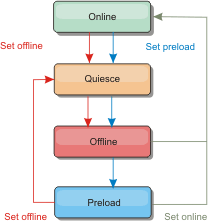WebSphere eXtreme Scale Administration Guide > Administer the WebSphere eXtreme Scale environment
|
| |
Setting the availability of an ObjectGrid
The availability state of an ObjectGrid instance determines which requests can be processed at any particular time.
There are four availability states:
- ONLINE
- QUIESCE
- OFFLINE
- PRELOAD
Figure 1. Availability states of an ObjectGrid

Set the availability state
The default availability state for an ObjectGrid is ONLINE. An ONLINE ObjectGrid is able to process any requests from a typical eXtreme Scale client. However, requests from a preload client are rejected while the ObjectGrid is ONLINE.
QUIESCE state is a transitional state. An ObjectGrid that is in QUIESCE will soon be in the OFFLINE state. While in QUIESCE, an ObjectGrid is allowed to process outstanding transactions. However, any new transactions will be rejected. An ObjectGrid can remain in QUIESCE for up to 30 seconds. After this time, the availability state will be moved to OFFLINE.
An ObjectGrid in the OFFLINE state will reject all transactions.
The PRELOAD state can be used to load data into an ObjectGrid from a preload client. While the ObjectGrid is in the PRELOAD state, only a preload client can commit transactions against the ObjectGrid. All other transactions will be rejected.
Use the StateManager interface to set the availability state of an ObjectGrid.
To set the availability state of an ObjectGrid running on the servers, pass a corresponding ObjectGrid client to the StateManager interface. The following code demonstrates how to change the availability state of an ObjectGrid.
ClientClusterContext client = ogManager.connect("localhost:2809", null, null);
ObjectGrid myObjectGrid = ogManager.getObjectGrid(client, "myObjectGrid");
StateManager stateManager = StateManagerFactory.getStateManager();
stateManager.setObjectGridState(AvailabilityState.OFFLINE, myObjectGrid);
Each shard of the ObjectGrid transitions to the desired state when the setObjectGridState method is called on the StateManager interface. When the method returns, all shards within the ObjectGrid should be in the proper state.
Use an ObjectGridEventListener plug-in to change the availability state of a server side ObjectGrid. Only change the availability state of a server-side ObjectGrid when the ObjectGrid has a single partition. If the ObjectGrid has multiple partitions, the shardActivated method is called on each primary, which results in superfluous calls to change the state of the ObjectGrid
public class OGListener implements ObjectGridEventListener,
ObjectGridEventGroup.ShardEvents {
public void shardActivated(ObjectGrid grid) {
StateManager stateManager = StateManagerFactory.getStateManager();
stateManager.setObjectGridState(AvailabilityState.PRELOAD, grid);
}
}
Because QUIESCE is a transitional state, you cannot use the StateManager interface to put an ObjectGrid into the QUIESCE state. An ObjectGrid passes through this state on its way to the OFFLINE state.
Retrive the availability state
Use the getObjectGridState method of the StateManager interface to retrieve the availability state of a particular ObjectGrid.StateManager stateManager = StateManagerFactory.getStateManager(); AvailabilityState state = stateManager.getObjectGridState(inventoryGrid);
The getObjectGridState method chooses a random primary within the ObjectGrid and returns its AvailabilityState. Because all shards of an ObjectGrid should be in the same availability state or transitioning to the same availability state, this method provides an acceptable result for the current availability state of the ObjectGrid.
Appropriate availability states for various requests
A request will be rejected if an ObjectGrid is not in the appropriate availability state to support that request. An AvailabilityException exception results whenever a request is rejected.
The initialState
attribute
You can use the initialState attribute on an ObjectGrid to indicate its startup state. Normally, when an ObjectGrid completes initialization, it is available for routing. The state can later be changed to prevent traffic from routing to an ObjectGrid. If the ObjectGrid needs to be initialized, but not immediately available, you can use the initialState attribute.
The initialState attribute is set on the ObjectGrid configuration XML file. The default state is ONLINE. Valid values include:
- ONLINE (default)
- PRELOAD
- OFFLINE
See the AvailabilityState API documentation for more information.
If initialState is set on an ObjectGrid, the state must be explicitly set back to online or the ObjectGrid will remain unavailable. It will throw AvailabilityExceptions.
Use
the initialState attribute for preloading
If the ObjectGrid is preloaded with data, there can be a period of time between when the ObjectGrid is available and switching to a preload state to block client traffic.
To avoid this time period, the initial state on an ObjectGrid can be set to PRELOAD. The ObjectGrid still completes all the necessary initialization, but it blocks traffic until the state has changed and allows the preload to occur.
The PRELOAD and OFFLINE states both block traffic, but use the PRELOAD state if to initiate a preload.
Failover and balancing
behavior
If a replica is promoted to a primary, it will not use the initialState setting. If the primary is moved for a rebalance, the initialState setting will not be used because the data is copied to the new primary location before the move is completed. If replication is not configured, then the primary goes into the initialState value if failover occurs and a new primary must be placed.